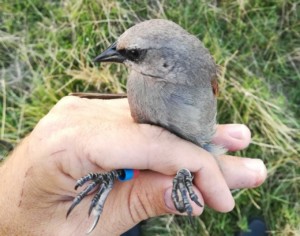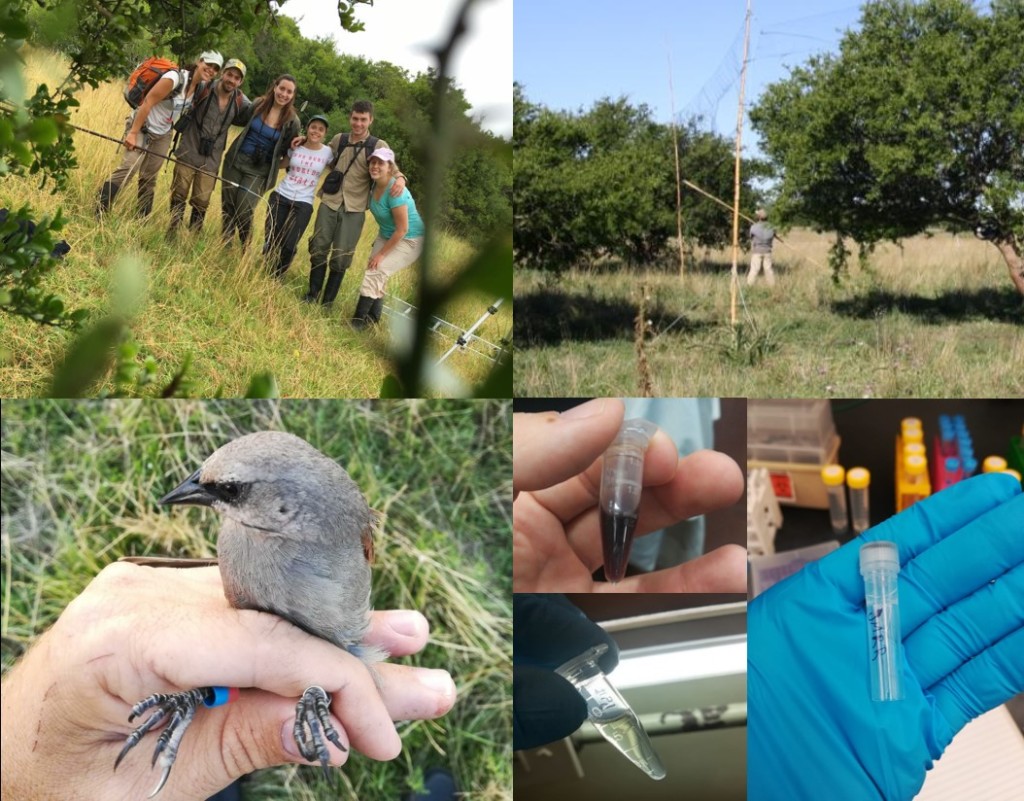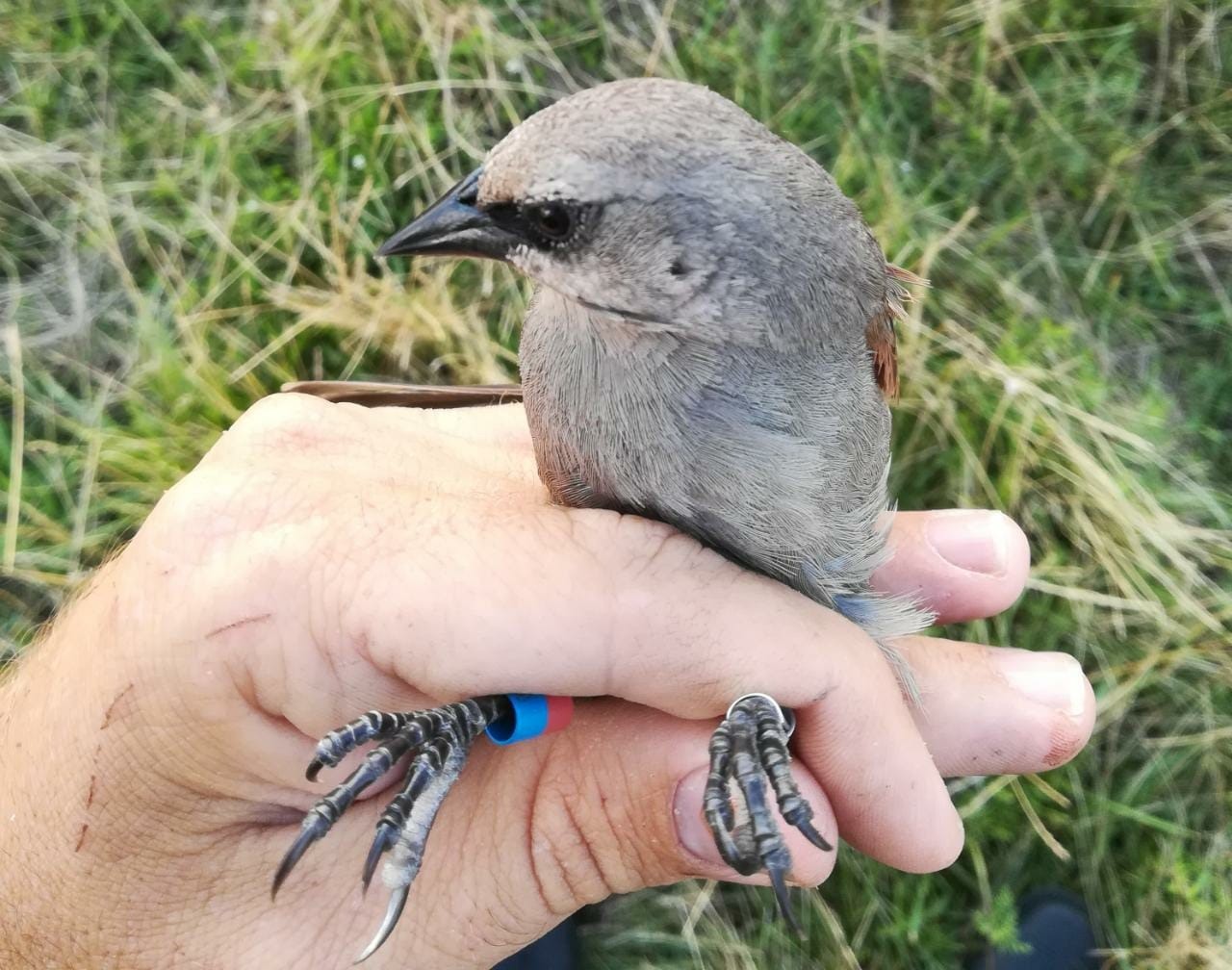 LINKED PAPER
LINKED PAPER
Family ties in a neotropical cooperative breeder: within-group relatedness and fine-scale genetic structure in the Greyish Baywing (Agelaioides badius). Rojas Ripari, J. M., Campagna, L., Mahler, B., Lovette, I., Reboreda, J. C., & De Mársico, M. C. 2022 Ibis. doi: 10.1111/ibi.13108 VIEW
Cooperative breeding has been under the scope of behavioral ecology for the last 30 years. It consists of an apparent altruistic behaviour in which helpers assist other individuals in their breeding attempt with parental care. The understanding of such breeding strategy builds on a foundational question: “Why do helpers help?”
Investing resources in others’ breeding attempts seems problematic in fitness terms and solving this puzzle has led to many possible answers. On one side, the strongest contender is kin selection (Griffin & West 2003 Hamilton 1964). By assisting a close relative, a helper may accrue inclusive fitness and, paraphrasing Dawkins (1976), increase the number of copies of (at least some) of his genes. Explaining cooperative breeding under kin selection assumes a monogamous mating system, as helpers would need to be certain that they are directing resources to close relative offspring. However, cooperative breeding occurs in a wide range of mating systems even in the most polygamous (Double et al. 2005). On this side of the potential benefits for helpers, access to extra-pair copulations seem to overcome the indirect genetic benefits. The second big candidate points to cooperative groups’ formation. In short lived systems such as those of Long-tailed Tits (Russel & Hatchwell 2001), individuals redirect help after failing in their own breeding attempt. Alternatively, in longer lived species such as Apostlebirds (Woxvold 2004), helpers are mainly philopatric offspring who assist their parents until they disperse and begin their own breeding attempt.
The void
The description and understanding of cooperative breeding species in the Neotropics, represents a large void in knowledge, despite it being the most biodiverse region of the world. The lack of long-term studies and the use of genomic tools makes the subject a goldmine for behavioural ecologists. One particular species is the Greyish Baywing (Agelaioides badius, hereafter Baywing). This medium sized passerine is native to southern South America and presents facultative cooperative breeding, where helping was originally associated with philopatric offspring following behavioral observations (re-sighting of banded individuals, Fraga 1991). Subsequently, a micro-satellite data-oriented study of the Baywing mating system revealed that its social monogamy was obscuring extra pair copulation in almost 40% of the sampled nests, where four of the eight genotyped helpers were previous offspring of the breeding pair (Ursino et al. 2017). Taking advantage of reduced-representation genomic techniques (Peterson et al. 2012) and intense sampling effort, this study built on previous work (Ursino et al. 2017) in order to take the next step in understanding this breeding system.

Figure 1 Cooperative group Baywings (first, third and fifth from left) taking care of fledglings (second and fourth from left). © Mercedes Burgueño
Intense fieldwork and genomics
Our team has been monitoring this species in the private reserve “El Destino” near the town of Magdalena (Buenos Aires province, Argentina). The reserve is part of the Parque Costero del Sur (MAB-UNESCO) and hosts relics of native forest (mainly Celtis ehrenbergiana and Scutia buxifolia) immersed in a matrix of low grasslands (Stipa sp., Spartina sp. and Juncus sp.). Here, Baywings are year-round residents and since 2003 have been studied within a framework of brood parasitism, as Baywings are the main host of the specialist Screaming Cowbird (Molothrus rufoaxillaris), seeking evidence of co-evolution (reviewed in De Mársico et al. 2019). Focus on the host breeding system started almost a decade later, with intensive use of mist netting to take blood samples and colour band the breeding pairs and their offspring (Ursino et al. 2011, 2017). During the 2015 to 2018 field seasons, there was special focus on capturing whole social groups. Once in the lab, after the breeding seasons ended and DNA was extracted from blood samples, we moved from traditional micro-satellite approach to genomics, specifically dd-RADseq (Thrasher et al. 2018). Shifting to more advanced technology allowed us to increase resolution and reduce sequencing times.

Figure 2 On the top row, the field team at the left and the setting up of mist nets by the author at the right. In the lower row, a banded Baywing at the left and the procedure of DNA extraction prior to Illumina sequencing (counterclockwise order of the lower-right quadrant). © Juan Manuel Rojas Ripari
Revealing results
Baywings seem not to fall within the categories explained above, as many paths may lead to helping. Most helpers were males closely related to the breeding pair or the breeding male. However, exceptions to this pattern were also found. In lesser numbers, we sampled male helpers who were not related to the breeding pair and also did not sire any of the raised nestlings. We also sampled two female helpers. In this case they were not related to the breeding pair, nor did they gain any reproductive benefits. In addition, when analyzing relatedness patterns in a spatial autocorrelation analysis we found a weak fine-scale genetic structure. Apparently Baywing helpers prefer to stay in familiar groups, but such familiar groups may not stay at the same site between breeding seasons. Although kin selection seems a strong driving force in this system, at least one third of the sampled helpers were not genetically related to the assisted pair. Surprisingly, those individuals did not gain reproductive benefits within the assisted group. Could they be juveniles that did not find their family to assist but were still not are able to face the cost of their first reproduction? Could they be philopatric extra-pair nestlings? Who are the female helpers? We may shed light on those questions in the near future by incorporating real-time sampling techniques such as RFID.

Figure 3 Baywing with a PIT-tag ring (the red ring above the metal ring). © Juan Manuel Rojas Ripari
Working in the global south leaves more open questions than the original research. It seems that breeding systems and life history traits work under different rules in the region and filling that void is of absolute importance (Wells & Barker 2018). Only by maintaining long-term studies and incorporating updated population genomic techniques can we update and rebuild the state of art of cooperative breeding in Neotropical ornithology.
References
Dawkins, R. 1976. The selfish gene. Oxford University Press.
Double, M. C., Peakall, R., Beck, N. R., & Cockburn, A. 2005. Dispersal, philopatry, and infidelity: dissecting local genetic structure in Superb Fairy-Wrens (Malurus Cyaneus). Evolution 59: 625–635. VIEW
Peterson, B. K., Weber, J. N., Kay, E. H., Fisher, H. S., & Hoekstra, H. E. 2012. Double digest RADseq: An inexpensive method for de novo SNP discovery and genotyping in model and non-model species. PLoS ONE 7(5). VIEW
Russell, A. F., & Hatchwell, B. J. 2001. Experimental evidence for kin-biased helping in a cooperatively breeding vertebrate. Proceedings of the Royal Society B: Biological Sciences 268(1481): 2169–2174. VIEW
Thrasher, D. J., Butcher, B. G., Campagna, L., Webster, M. S., & Lovette, I. J. 2018. Double-digest RAD sequencing outperforms microsatellite loci at assigning paternity and estimating relatedness: A proof of concept in a highly promiscuous bird. Molecular Ecology Resources 18(5): 953–965. VIEW
Ursino, C. A., De Mársico, M. C., Sued, M., Farall, A., & Reboreda, J. C. 2011. Brood parasitism disproportionately increases nest provisioning and helper recruitment in a cooperatively breeding bird. Behavioral Ecology and Sociobiology 134(2): 2279–2286. VIEW
Ursino, C. A., De Mársico, M. C., Reboreda, J. C., & Riehl, C. 2017. Kinship and genetic mating system of the Grayish Baywing (Agelaioides badius), a cooperatively breeding Neotropical blackbird. The Auk 65(12): 410–420. VIEW
Woxvold, I. A. 2004. Breeding ecology and group dynamics of the apostlebird. Australian Journal of Zoology 52(6): 561–581. VIEW
Image credit
Top right: Greyish Baywing Agelaioides badius © Juan Manuel Rojas Ripari
If you want to write about your research in #theBOUblog, then please see here.




